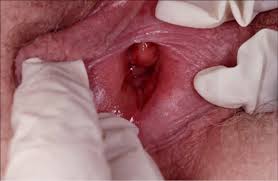Atrophic Vaginitis Causes Symptoms and Treatment
What is atrophy of the uterus?
Atrophic vaginitis (vaginal atrophy) is a gynecological pathological disorder affecting mainly elderly women, it is characterized by mucosal atrophy, erosions, friability, and telangiectasia of the vagina. Atrophic vaginitis (and urethritis) can cause urinary incontinence; these pathologies usually arise from an underlying problem in the lower urinary tract.[1]
Symptoms
What are the symptoms of atrophic vaginitis?
- Scant and alkaline vaginal discharge
- Vaginal pain
- Vaginal irritation
- Dyspareunia or pain during intercourse, especially in postmenopausal women
- Vaginal dryness and loss of lubrication
- Spotting after intercourse, especially in postmenopausal women
- Frequent vaginal infections
- Frequent UTI (urinary tract infections)
- Dysuria (painful urination), discomfort or burning during urination
Causes
What causes atrophy of the uterus and what does atrophic endometrium mean??
Estrogen deficit in the postmenopausal period is the most common cause of atrophic vaginitis, as estrogen deficiency cause the vaginal mucosa to thin, thus making it more vulnerable to trauma and infections, thinning results in irritation from minor scratches
Treatment
How to treat atrophic vaginitis?
Vaginal estrogen-based drugs and vaginal lubricants and moisturizers are currently recommended as first-line treatment of vaginal atrophy when only vaginal symptoms are present.
- Periodic checkups are obligatory during the course of treatment and recovery
- Perineal hygiene (peri care) is a term used to describe washing the genitals and anal area, which can be done during a bath or as a separate procedure, it is an important therapy to prevent infection, and odor.
- Hormone replacement therapy (HRT) is the gold standard treatment for Atrophic vaginitis, topical and systemic estrogens provide the best treatment for atrophic vaginitis; however, Systemic HRT is not usually recommended as first-line treatment for women with atrophic vaginitis. Vagifem (Estradiol Vaginal Tablets), a single insert with 1 dose of Vagifem® 10 mcg, or Premarin® brand vaginal cream are used to treat vaginal dryness and discomfort in women or girls of any age.[12][13][14]
What are the side effects of taking Vagifem (estradiol vaginal inserts)?
Common side effects of Vagifem may include:
- Breast pain and discharge
- Breast swelling
- Vaginal irritation and discharge
- Vaginal itching
- Stomach pain and bloating and nausea
- Stomach cramps and diarrhea
- Ankle or feet edema
- Headache (migraine)
- Dizziness
- Flu like symptoms such as running nose, sneezing, sore throat
Ospemifene (Osphena) is a non-estrogen oral medication used for the treatment of dyspareunia in menopausal women.[9][10][11]
Intrarosa Vaginal Inserts (Prasterone) is a vaginally administered steroid used to relieve dyspareunia, and vaginal atrophy due to menopause. Vaginal insert 6.5 mg once daily at bedtime using the provided applicator.[6][7]
DHEA (dehydroepiandrosterone) is a pro-hormone supplement (an endogenous steroid) used to relieve pain during sexual intercourse.
Non-hormonal treatment for atrophic vaginitis (vaginal dryness):
Lubricants for atrophic vaginitis, vaginal lubricants can improve dryness during intercourse; however, these lubricants provide short term relief. Common lubricants for vaginal dryness include:
- Sylk Natural Intimate Lubricant 40g.[2]
- Replens Silky Smooth Personal Lubricant 2.7 fl oz (silicone based lubricant).[5]
- Yes OB plant-oil based lubricants, or YES WB water based lubricant.[3]
Bioadhesive vaginal moisturizers (non-hormonal vaginal moisturizers) can help epithelial cells on the vaginal wall retain moisture and can also lower vaginal pH. Common vaginal moisturizers include:
- Replens MD Vaginal Moisturiser 35g, one application 2.5 g, three times weekly, for an initial period of 3 months.[5]
- Hyalofemme Vaginal Dryness and Irritation Relief Moisturiser Gel 30g (Hyalofemme fast acting vaginal moisturizer).[4]
- Vaseline (to be applied to the vulva to protect the skin).[8]
Next steps management
How to diagnose atrophic vaginitis?
- A general medical examination (taking a complete medical history and gathering information about the duration, odor and color of the vaginal discharge, performing a brief or complete physical examination, and sometimes involves ordering laboratory tests, and mammography).
- Pelvic ultrasound
- Full investigation and inspection of the vagina, investigating carefully the color, odor, consistency of the discharge
- Collecting vaginal, genital, or cervical specimens (swab of vagina, cervix, vaginal discharge, endocervical aspirate, or urethral discharge) for culture.
- Pelvic examination
References
Verified by: Dr.Diab (October 10, 2017)
Citation: Dr.Diab. (October 10, 2017). Atrophic Vaginitis Causes Symptoms and Treatment. Medcoi Journal of Medicine, 11(2). urn:medcoi:article15759.














There are no comments yet
Or use one of these social networks